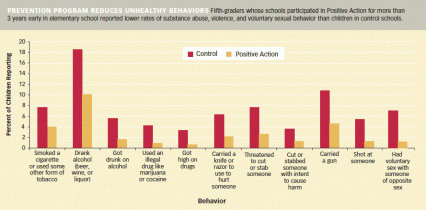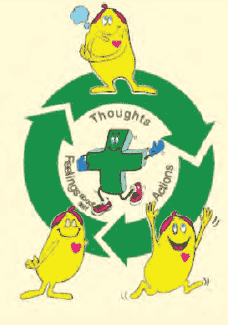Positive Action, a school-centered program for social and emotional development for grades 1 to 12, was credited with a sharp reduction in rates of substance abuse, violent behavior, and voluntary sexual activity among primary school children in a recent NIDA-funded study. Hawaiian fifth-graders who had participated in the program for 3 or 4 years self-reported most of these problem behaviors half as frequently, or less, compared with peers who were not exposed to it. Lead investigator Dr. Brian Flay of Oregon State University notes that behavioral problems increase sharply after fifth grade; if the observed reductions carry into later ages, the benefit to students, their families, and their communities will be great.
Do Good, Feel Good
Teachers are the central actors in Positive Action. In 140 lessons—roughly 35 hours of instruction—per academic year, they cover a curriculum based on a simple core philosophy: "You feel good about yourself when you do positive actions; you feel bad about yourself when you do negative actions." Each lesson encourages healthy behavior and academic achievement through specific positive acts—for example, eating good food, doing homework, reading for fun, sleeping regularly, not consuming harmful substances, getting along with others, and developing self-control. At any given time, teachers of every grade focus on the same topic at age-appropriate levels to reinforce and solidify concepts throughout the school.
 Prevention Program Reduces Unhealthy Behaviors: Fifth-graders whose schools participated in Positive Action for more than 3 years early in elementary school reported lower rates of substance abuse, violence, and voluntary sexual behavior than children in control schools.
Prevention Program Reduces Unhealthy Behaviors: Fifth-graders whose schools participated in Positive Action for more than 3 years early in elementary school reported lower rates of substance abuse, violence, and voluntary sexual behavior than children in control schools.School principals and counselors, family members, and community leaders also have roles in Positive Action, ensuring that school, home, and community climates reflect the program's aims.
Complete program materials for all these groups cost approximately $450 per classroom, excluding teacher training (www.positiveaction.net).
Positive Action Versus Business as Usual
The 1,714 boys and girls who reported their experiences in the recent study were ethnically diverse, and the mix was similar to that of the state, with the majority being of Hawaiian, Asian, or multiple ethnicities. Participants attended 20 public elementary schools in which at least one-quarter of students received free or reduced-price lunches, and academic achievement levels were moderate to low compared with the average of Hawaiian schools. The researchers divided the schools into 10 pairs, each of which was closely matched based on a lengthy list of characteristics that might influence rates of problem behaviors. One school in each pair was randomly assigned to implement Positive Action, the other to carry on as usual.
The fifth-graders' self-reports indicated that most of the problem behaviors were uncommon, as would be expected among children so young. However, the intervention group had lower levels than the control group among all the behaviors except for a few in which there was no measurable difference. The most widely acknowledged problem behavior was drinking alcohol (10 percent among Positive Action participants, 19 percent among controls), and the least reported was getting high on drugs (0.7 percent Positive Action participants, 3.5 percent controls).
The teachers of the Positive Action recipients reported significantly fewer behavioral problems among their students than teachers of control children did among theirs; however, differences between teacher reports were smaller than those between student self-reports.
Dr. Flay says that the findings substantiate favorable results from a concurrent study of Positive Action in Chicago public schools. They also are consonant with studies that have shown similar benefits from other programs that share the strategy of inculcating healthy habits in early childhood to prevent problems throughout individuals' development ("Behavior Game Played in Primary Grades Reduces Later Drug-Related Problems"). Moreover, the benefits of such programs may endure into the critical teenage years. Dr. Flay and colleagues have found that among middle and high schools in another region of the country, the higher the percentage of students completing the Positive Action program, the lower the rates of student smoking.
"When You Do Good, You Feel Good"
The thoughts-actions-feelings cycle that is shown on posters and stickers reminds children of the Positive Action program's central idea. Six units each focus on a specific theme.

- Developing self-concept: What it is, how it's formed, and why it's important (philosophy and thoughts-actions-feelings circle)
- Maintaining a healthy body and mind (includes motivation to learn)
- Managing yourself responsibly (self-control skills)
- Getting along with others by treating them the way you like to be treated (social-emotional skills and character)
- Being honest with yourself and others (mental health)
- Improving yourself continually (setting and achieving goals)
Other Outcomes
One year after the study, Positive Action schools demonstrated improved standardized test scores for reading and math compared with the year prior to program implementation. For example, fifth-graders at intervention schools scored about 10 percent higher in reading and about 9 percent higher in math on the TerraNova test (2nd edition). Analyses of administrative data before and after program implementation indicated that Positive Action schools lowered absenteeism by about 15 percent, reduced suspensions by 73 percent, and held students back a grade 73 percent less often.
"Children hear many mixed messages about what is appropriate and often do not know positive behaviors when they enter school," says Dr. Flay. "Through Positive Action, adults can teach and instill motivation for pro-social behaviors and encourage healthy emotional responses. In this way, the program reduces a range of problem behaviors by offsetting broader dysfunction in classrooms, schools, and communities," says Dr. Flay.
"The advantages conferred by Positive Action and other early skill-development programs are exciting to see," says Dr. Aria Crump of NIDA's Division of Epidemiology, Services and Prevention Research. "Also, the fact that this intervention has been tested with diverse populations provides support for the generalizability of this approach."
Sources
Snyder, F.J., et al. Impact of the Positive Action program on school-level indicators of academic achievement, absenteeism, and disciplinary outcomes: A matched-pair, cluster randomized, controlled trial. Journal of Research on Educational Effectiveness 3(1):26-55, 2010. [Full Text]
Beets, M.W., et al. Use of a social and character development program to prevent substance use, violent behaviors, and sexual activity among elementary-school students in Hawaii. American Journal of Public Health 99(8):1438-1445, 2009. [Full Text (PDF, 515KB)]
Flay, B.R. School-based smoking prevention programs with the promise of long-term effects. Tobacco Induced Diseases 5(1):6, 2009. [Full Text (PDF, 406KB)]
